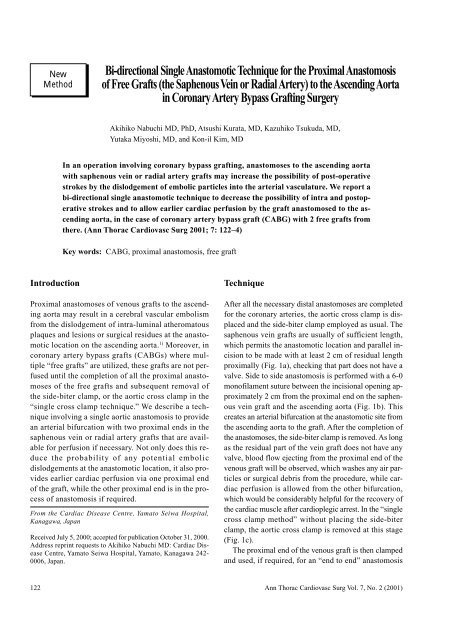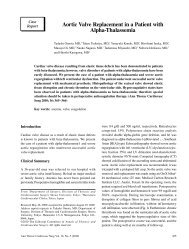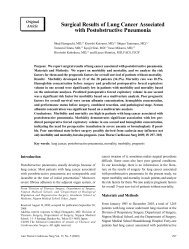Bi-directional Single Anastomotic Technique for the Proximal ...
Bi-directional Single Anastomotic Technique for the Proximal ...
Bi-directional Single Anastomotic Technique for the Proximal ...
Create successful ePaper yourself
Turn your PDF publications into a flip-book with our unique Google optimized e-Paper software.
<strong>Bi</strong>-<strong>directional</strong> <strong>Single</strong> <strong>Anastomotic</strong> <strong>Technique</strong> <strong>for</strong> <strong>the</strong> <strong>Proximal</strong> Anastomosisof Free Grafts (<strong>the</strong> Saphenous Vein or Radial Artery) to <strong>the</strong> Ascending Aortain Coronary Artery Bypass Grafting SurgeryAkihiko Nabuchi MD, PhD, Atsushi Kurata, MD, Kazuhiko Tsukuda, MD,Yutaka Miyoshi, MD, and Kon-il Kim, MDIn an operation involving coronary bypass grafting, anastomoses to <strong>the</strong> ascending aortawith saphenous vein or radial artery grafts may increase <strong>the</strong> possibility of post-operativestrokes by <strong>the</strong> dislodgement of embolic particles into <strong>the</strong> arterial vasculature. We report abi-<strong>directional</strong> single anastomotic technique to decrease <strong>the</strong> possibility of intra and postoperativestrokes and to allow earlier cardiac perfusion by <strong>the</strong> graft anastomosed to <strong>the</strong> ascendingaorta, in <strong>the</strong> case of coronary artery bypass graft (CABG) with 2 free grafts from<strong>the</strong>re. (Ann Thorac Cardiovasc Surg 2001; 7: 122–4)Key words: CABG, proximal anastomosis, free graftIntroduction<strong>Proximal</strong> anastomoses of venous grafts to <strong>the</strong> ascendingaorta may result in a cerebral vascular embolismfrom <strong>the</strong> dislodgement of intra-luminal a<strong>the</strong>romatousplaques and lesions or surgical residues at <strong>the</strong> anastomoticlocation on <strong>the</strong> ascending aorta. 1) Moreover, incoronary artery bypass grafts (CABGs) where multiple“free grafts” are utilized, <strong>the</strong>se grafts are not perfuseduntil <strong>the</strong> completion of all <strong>the</strong> proximal anastomosesof <strong>the</strong> free grafts and subsequent removal of<strong>the</strong> side-biter clamp, or <strong>the</strong> aortic cross clamp in <strong>the</strong>“single cross clamp technique.” We describe a techniqueinvolving a single aortic anastomosis to providean arterial bifurcation with two proximal ends in <strong>the</strong>saphenous vein or radial artery grafts that are available<strong>for</strong> perfusion if necessary. Not only does this reduce<strong>the</strong> probability of any potential embolicdislodgements at <strong>the</strong> anastomotic location, it also providesearlier cardiac perfusion via one proximal endof <strong>the</strong> graft, while <strong>the</strong> o<strong>the</strong>r proximal end is in <strong>the</strong> processof anastomosis if required.From <strong>the</strong> Cardiac Disease Centre, Yamato Seiwa Hospital,Kanagawa, JapanReceived July 5, 2000; accepted <strong>for</strong> publication October 31, 2000.Address reprint requests to Akihiko Nabuchi MD: Cardiac DiseaseCentre, Yamato Seiwa Hospital, Yamato, Kanagawa 242-0006, Japan.<strong>Technique</strong>After all <strong>the</strong> necessary distal anastomoses are completed<strong>for</strong> <strong>the</strong> coronary arteries, <strong>the</strong> aortic cross clamp is displacedand <strong>the</strong> side-biter clamp employed as usual. Thesaphenous vein grafts are usually of sufficient length,which permits <strong>the</strong> anastomotic location and parallel incisionto be made with at least 2 cm of residual lengthproximally (Fig. 1a), checking that part does not have avalve. Side to side anastomosis is per<strong>for</strong>med with a 6-0monofilament suture between <strong>the</strong> incisional opening approximately2 cm from <strong>the</strong> proximal end on <strong>the</strong> saphenousvein graft and <strong>the</strong> ascending aorta (Fig. 1b). Thiscreates an arterial bifurcation at <strong>the</strong> anastomotic site from<strong>the</strong> ascending aorta to <strong>the</strong> graft. After <strong>the</strong> completion of<strong>the</strong> anastomoses, <strong>the</strong> side-biter clamp is removed. As longas <strong>the</strong> residual part of <strong>the</strong> vein graft does not have anyvalve, blood flow ejecting from <strong>the</strong> proximal end of <strong>the</strong>venous graft will be observed, which washes any air particlesor surgical debris from <strong>the</strong> procedure, while cardiacperfusion is allowed from <strong>the</strong> o<strong>the</strong>r bifurcation,which would be considerably helpful <strong>for</strong> <strong>the</strong> recovery of<strong>the</strong> cardiac muscle after cardioplegic arrest. In <strong>the</strong> “singlecross clamp method” without placing <strong>the</strong> side-biterclamp, <strong>the</strong> aortic cross clamp is removed at this stage(Fig. 1c).The proximal end of <strong>the</strong> venous graft is <strong>the</strong>n clampedand used, if required, <strong>for</strong> an “end to end” anastomosis122 Ann Thorac Cardiovasc Surg Vol. 7, No. 2 (2001)
with ano<strong>the</strong>r graft to ano<strong>the</strong>r coronary artery. Ideally, <strong>the</strong>“end to end” anastomosis and sutures should be fashionedobliquely at an angle to <strong>the</strong> grafts to produce awide anastomosis and to avoid stenosis (Figs. 1d, 2, 3).There was no difference in technique whe<strong>the</strong>r <strong>the</strong> o<strong>the</strong>rgraft was a saphenous vein, radial artery, or free internalmammary graft.Discussion<strong>Bi</strong>-<strong>directional</strong> <strong>Single</strong> <strong>Anastomotic</strong> <strong>Technique</strong> <strong>for</strong> <strong>Proximal</strong> Anastomisis in CABGCABG with <strong>the</strong> above-described technique was per<strong>for</strong>med<strong>for</strong> 83 patients since September 1997, out of 473total CABG. End to end anastomosis was per<strong>for</strong>med betweensaphenous vein and radial artery in 24 patients,saphenous vein graft and free internal mammary arteryin 3, saphenous vein to saphenous vein in <strong>the</strong> rest. Therewas an angiographical occlusion at <strong>the</strong> end to end anastomoticsite in 3 patients out of 83 patients studied immediatelyafter surgery, and no occlusion in <strong>the</strong> longtermperiod out of 41 patients studied over 12 months.The described technique has 3 beneficial aspects comparedwith <strong>the</strong> conventional technique where <strong>the</strong> proximalends of <strong>the</strong> grafts are anastomosed at different siteson <strong>the</strong> aorta. Firstly, only one anastomosis is necessaryin <strong>the</strong> ascending aorta to provide a bifurcation <strong>for</strong> potentiallytwo venous grafts, <strong>the</strong>reby reducing <strong>the</strong> probabilityof any potential embolic dislodgements from intraluminala<strong>the</strong>romatous plaques and lesions. Secondly, <strong>the</strong>brief period during which blood is ejected from <strong>the</strong> proxi-Fig. 1. Side to side anastomosis is per<strong>for</strong>med with a 6-0 monofilamentsuture between <strong>the</strong> incision opening approximately 2 cmfrom <strong>the</strong> proximal end on <strong>the</strong> saphenous vein graft and <strong>the</strong> ascendingaorta (a, b). After <strong>the</strong> completion of <strong>the</strong> anastomosis,<strong>the</strong> aortic cross clamp, or <strong>the</strong> side-biter clamp is removed, whilecardiac perfusion is allowed from <strong>the</strong> o<strong>the</strong>r bifurcation (c). Theproximal end of <strong>the</strong> venous graft is <strong>the</strong>n clamped and used <strong>for</strong>an “end to end” anastomosis with ano<strong>the</strong>r graft to ano<strong>the</strong>r coronaryartery. Ideally, <strong>the</strong> “end to end” anastomosis and suturesshould be fashioned obliquely at an angle to <strong>the</strong> grafts to producea wide anastomosis and to avoid stenosis (d).Fig. 2. The photograph is showing <strong>the</strong>view after completion of both anastomoses,side to side anastomosis of <strong>the</strong>vein graft with <strong>the</strong> ascending aorta(black arrow) and end to end anastomosisbetween <strong>the</strong> vein grafts (whitearrow).Ann Thorac Cardiovasc Surg Vol. 7, No. 2 (2001)123
Nabuchi et al.mal end of <strong>the</strong> graft after <strong>the</strong> removal of <strong>the</strong> side-biterclamp has <strong>the</strong> added advantage of completely washingout any particles of air, dust, fatty tissue, a<strong>the</strong>romatouslesions or surgical debris that are trapped in <strong>the</strong> anastomosisduring <strong>the</strong> procedure. Thirdly, <strong>the</strong> bifurcation createdallows one side of <strong>the</strong> graft to be perfused while <strong>the</strong>o<strong>the</strong>r is clamped and anastomosed to ano<strong>the</strong>r graft if necessary,whereas <strong>the</strong> conventional approach requires allanastomoses to be completed be<strong>for</strong>e perfusion is possible.Some descriptions about CABG did not discouragesurgeon to per<strong>for</strong>m “end to end” anastomosis betweengrafts. 2,3) This technique has not been reported in <strong>the</strong> literaturesclearly, but this will bring some benefits to <strong>the</strong>surgeon obviously.ReferenceFig. 3. Postoperative angiogram of <strong>the</strong> grafts in this technique inan 83-year-old female per<strong>for</strong>med 10 months after CABG. Bothof <strong>the</strong> anastomotic sites, side to side anastomosis with <strong>the</strong> ascendingaorta (black arrow), and end to end anastomosis between<strong>the</strong> saphenous vein grafts (white arrow) are clearly shownwithout having any stenosis.1. Mickleborough LL, Walker DM, Takagi Y. Risk factor<strong>for</strong> stroke in patients undergoing coronary artery bypassgrafting. J Thoracic Cardiovasc Surg 1996; 112:1250–9.2. Buxton B, Smith J, Foller J. Incorrect graft length,standard grafting technique. In: Buxton B ed. IschemicHeart Disease Surgical Management. London: Mosby,1999; p 200.3. Calafiore A. Composite grafts using <strong>the</strong> internal thoracicartery, radial artery, and inferior epigastric artery.In: Buxton B ed. Ischemic Heart Disease SurgicalManagement. London: Mosby, 1999; pp 217–9.124Ann Thorac Cardiovasc Surg Vol. 7, No. 2 (2001)








